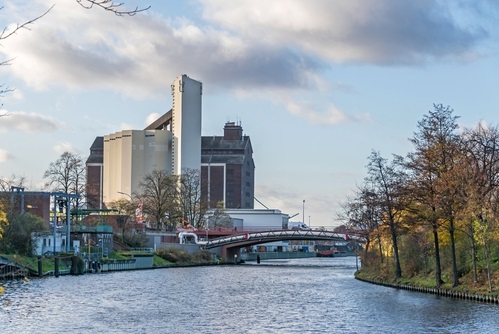
 Data Structure
Data Structure Networking
Networking RDBMS
RDBMS Operating System
Operating System Java
Java MS Excel
MS Excel iOS
iOS HTML
HTML CSS
CSS Android
Android Python
Python C Programming
C Programming C++
C++ C#
C# MongoDB
MongoDB MySQL
MySQL Javascript
Javascript PHP
PHP
- Selected Reading
- UPSC IAS Exams Notes
- Developer's Best Practices
- Questions and Answers
- Effective Resume Writing
- HR Interview Questions
- Computer Glossary
- Who is Who
What is the Principle of Fluidized Bed Combustion (FBC) And How Does It Work?
Introduction
Fluidized bed combustion (FBC) is a technology used for combustion of solid fuels such as coal, biomass, and municipal waste. It is an efficient and environmentally friendly method for generating energy from solid fuels. FBC technology was developed in the 1960s and has since been widely used in power plants, industrial processes, and waste-to-energy plants. In this article, we will discuss the principle of fluidized bed combustion and how it works.

Principle of Fluidized Bed Combustion
The principle of fluidized bed combustion is based on the formation of a fluidized bed of solid particles, which are suspended in an upward flow of gas (air or gasified fuel).
The fluidized bed is formed when the upward flow of gas is sufficient to cause the solid particles to be lifted and suspended in the gas stream.
The solid particles behave like a fluid and exhibit fluid-like properties, such as the ability to flow and mix.
The fluidized bed provides an environment where combustion can occur at a relatively low temperature, typically between 800°C and 900°C.
The fluidized bed is an important component of the FBC system. The fluidized bed consists of a bed of solid particles, typically sand, limestone, or dolomite, which are fluidized by the upward flow of gas.
The bed of solid particles is maintained in a state of turbulence by the gas flow, which promotes mixing and enhances heat transfer. The fluidized bed provides a large surface area for combustion, which increases the efficiency of the process.
The fluidized bed combustion process involves several stages. In the first stage, the fuel is introduced into the fluidized bed, where it is heated and partially oxidized. The partially oxidized fuel reacts with the oxygen in the gas stream to produce combustion products, such as carbon dioxide and water vapor. The combustion products are carried out of the fluidized bed by the gas stream.
In the second stage, the combustion products are cooled, and the heat is extracted. The heat can be used to generate steam, which can be used to generate electricity or for industrial processes. The cooled combustion products are then cleaned to remove pollutants such as sulfur dioxide and nitrogen oxides.
What a Fluidized Bed Combustion Work
The fluidized bed combustion process is a complex process that involves several stages. The process starts with the fuel being fed into the fluidized bed. The fuel can be in the form of coal, biomass, or municipal waste. The fuel is mixed with the bed material, which is typically sand, limestone, or dolomite.
The bed material is heated by the gas flow, which causes the particles to become fluidized. The fluidized bed provides a large surface area for combustion to occur. As the fuel is heated, it begins to release volatile components, such as hydrogen and carbon monoxide. These volatile components react with the oxygen in the gas stream to produce combustion products.
The combustion products are carried out of the fluidized bed by the gas stream. The gas stream contains combustion products, such as carbon dioxide and water vapor, as well as unburned fuel and other pollutants, such as sulfur dioxide and nitrogen oxides.
The combustion products are then cooled, and the heat is extracted. The heat can be used to generate steam, which can be used to generate electricity or for industrial processes. The cooled combustion products are then cleaned to remove pollutants such as sulfur dioxide and nitrogen oxides.
Advantages of Fluidized Bed Combustion
Fluidized bed combustion has several advantages over traditional combustion technologies. One of the main advantages is its ability to burn a wide range of fuels, including low-grade coal, biomass, and municipal waste. This makes it a versatile technology that can be used in a variety of applications. Another advantage of fluidized bed combustion is its high efficiency.
FAQs
Q1. What is the fluidizing agent in fluidized bed combustion?
Ans. The fluidizing agent in fluidized bed combustion is typically air or gasified fuel.
Q2. What are the advantages of fluidized bed combustion?
Ans. Fluidized bed combustion has several advantages, including its ability to burn a wide range of fuels, its high efficiency, and its ability to reduce emissions.
Q3. What types of fuels can be used in fluidized bed combustion?
Ans. Fluidized bed combustion can burn a wide range of fuels, including coal, biomass, and municipal waste.
Q4. What is the temperature range for fluidized bed combustion?
Ans. The temperature range for fluidized bed combustion is typically between 800°C and 900°C.
Q5. What happens to the combustion products in fluidized bed combustion?
Ans. The combustion products in fluidized bed combustion are carried out of the fluidized bed by the gas stream, cooled, and then cleaned to remove pollutants such as sulfur dioxide and nitrogen oxides. The heat from the combustion products can be used to generate steam for electricity or industrial processes.

